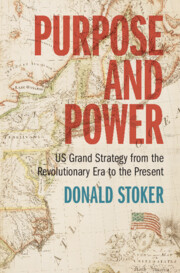Book contents
- Purpose and Power
- Purpose and Power
- Copyright page
- Dedication
- Contents
- Figures
- Maps
- Abbreviations
- Thinking about Grand Strategy in Peace and War
- Part I From Backwater to Great Power
- Part II From Great Power to Superpower
- 7 Stepping upon the Global Stage, 1913–1921
- 8 The Interwar Interlude, 1921–1939
- 9 Moving Astride the World: The Second World War, 1939–1945
- 10 The Hot Peace and the Korean War, 1945–1953
- 11 The Hot Peace: The Eisenhower, Kennedy, And Johnson Years, 1953–1969
- 12 The Vietnam War, 1961–1969
- 13 Détente and Defeat: Nixon, Ford, and Vietnam, 1969–1977
- 14 For Want of a Vision: The Carter Years, 1977–1981
- 15 Winning the Hot Peace: Reagan’s Great-Power Competition, 1981–1990
- Part III The Post–Cold War World
- Part IV Retreat and Defeat
- Acknowledgements
- Notes
- Index
11 - The Hot Peace: The Eisenhower, Kennedy, And Johnson Years, 1953–1969
from Part II - From Great Power to Superpower
Published online by Cambridge University Press: 11 January 2024
- Purpose and Power
- Purpose and Power
- Copyright page
- Dedication
- Contents
- Figures
- Maps
- Abbreviations
- Thinking about Grand Strategy in Peace and War
- Part I From Backwater to Great Power
- Part II From Great Power to Superpower
- 7 Stepping upon the Global Stage, 1913–1921
- 8 The Interwar Interlude, 1921–1939
- 9 Moving Astride the World: The Second World War, 1939–1945
- 10 The Hot Peace and the Korean War, 1945–1953
- 11 The Hot Peace: The Eisenhower, Kennedy, And Johnson Years, 1953–1969
- 12 The Vietnam War, 1961–1969
- 13 Détente and Defeat: Nixon, Ford, and Vietnam, 1969–1977
- 14 For Want of a Vision: The Carter Years, 1977–1981
- 15 Winning the Hot Peace: Reagan’s Great-Power Competition, 1981–1990
- Part III The Post–Cold War World
- Part IV Retreat and Defeat
- Acknowledgements
- Notes
- Index
Summary
The Dwight David Eisenhower administration launched a security reassessment known as Project Solarium. This produced a new grand strategy known as the New Look. Eisenhower wanted to cut the cost of defense and famously warned about the dangers of the “military-industrial complex.” A solution was a reliance on atomic and then nuclear weapons. These were cheaper than standing forces. Eisenhower also stressed economic support abroad, alliance relationships, information operations, and subversion of Communist-leaning states abroad such as Guatemala and Iran. Secretary of State Dean Acheson gave us “brinksmanship” and “massive retaliation.” John F. Kennedy succeeded Eisenhower and criticized him for a supposed “missile gap” with the Soviet Union. Kennedy promulgated no official national security strategy but developed a grand strategy known as Flexible Response. His administration abandoned Eisenhower’s near-total dependence on nuclear weapons for a broader defense strategy. He faced crises in Berlin and particularly in Cuba. Secretary of Defense Robert McNamara gave us MAD – mutually assured destruction. Kennedy moved America from an advising to a combat role in South Vietnam.
Keywords
- Type
- Chapter
- Information
- Purpose and PowerUS Grand Strategy from the Revolutionary Era to the Present, pp. 390 - 415Publisher: Cambridge University PressPrint publication year: 2024

